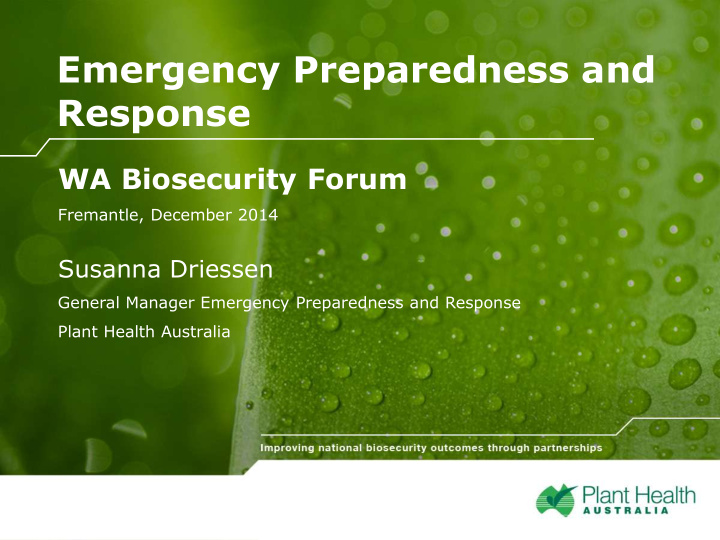



Emergency Preparedness and Click to edit Response WA Biosecurity Forum Sub-heading Fremantle, December 2014 Susanna Driessen General Manager Emergency Preparedness and Response Plant Health Australia
Outline of presentation Role of Plant Health Australia – who are we and what do we do Australia’s biosecurity system – challengers and drivers PHA members addressing risk The national Emergency Plant Pest Response Deed (EPPRD)
Click to edit Plant Health Australia Who are we and what do we do? Sub-heading
Plant Health Australia Not for profit, public company , member based. Provide national coordination to improve: biosecurity across Australia’s plant industries • capacity to respond to plant pest emergencies • Custodians of the Emergency Plant Pest Response Deed • Work with Members to build partnership arrangements and broker and facilitate between government and industry in the national interest. Our focus is on plant biosecurity.
Plant Health Australia Government members Industry members Associate members
Biosecurity continuum National biosecurity Protection from risks posed by pests to industry and the environment through exclusion, eradication and control Pre-Border Border Post-Border Identifying exotic pest threats Implementing effective Preparing for timely detection, quarantine for people, minimised spread and rapid Managing quarantine risks machinery, plants, and goods response to emergency pests offshore, inspections Establishing trapping and Domestic quarantine and Undertaking offshore surveillance market access research and development Inspections and treatments Surveillance and Awareness where pests are endemic Post entry plant quarantine Farm biosecurity Networks for pests that may Australian Government, bypass checkpoints PHA , State governments Australian Government Australian Government and industry Achieved through effective partnerships between industry, government and the community
What does PHA do? Plant biosecurity Emergency Plant snapshots Pest Response Deed PLANTPLAN Strategies Biosecurity Best practice Pest contingency Biosecurity awareness Planning awareness planning material
PHA Funding (A$’000) 8,000 7,000 6,000 5,000 4,000 3,000 2,000 1,000 - Member subscriptions Government Projects Industry Projects Interest Total
Click to edit Biosecurity in Australia A strong biosecurity system is critical Sub-heading
Agricultural Production ( A$’m ) 50 000 45 000 40 000 35 000 30 000 25 000 20 000 15 000 10 000 5 000 0 Total crops & forestry Total crops, hay & forestry Total crops, hay, pasture & forestry Total Livestock
Agricultural Exports ( A$’m ) 30000 25000 20000 15000 10000 5000 0 Crops Livestock
Not just protecting agriculture
Challenges and drivers Globalisation – tourism and trade Financial constraints (more with less, where to invest) Changing landscape and primary production practices (peri- urban/urban production, northern Australia) Shortage of qualified professionals Climate change
Globalisation Visitors arriving (Short Term) trend 100000 200000 300000 400000 500000 600000 700000 0 Jan-1976 Nov-1976 Sep-1977 Jul-1978 May-1979 Mar-1980 Jan-1981 Nov-1981 Sep-1982 Jul-1983 May-1984 Mar-1985 (ABS data 3401.0 Overseas arrivals and departures) Jan-1986 Visitors arriving (Short term) trend Nov-1986 Sep-1987 Jul-1988 May-1989 Mar-1990 Jan-1991 Nov-1991 Sep-1992 Jul-1993 May-1994 Mar-1995 Jan-1996 Nov-1996 Sep-1997 Jul-1998 May-1999 Mar-2000 Jan-2001 Nov-2001 Sep-2002 Jul-2003 May-2004 Mar-2005 Jan-2006 Nov-2006 Sep-2007 Jul-2008 May-2009 Mar-2010 Jan-2011 Nov-2011 Sep-2012 Jul-2013 May-2014
Air freight to Australia Air mail to Australia
Border interceptions 25000 20000 Number of interceptions 15000 19,070 19,040 18,578 18,618 19,810 10000 5000 0 2005 2006 2007 2008 2009 2010 2011 2012 Year Invertebrate Disease Seed Animal Plant
Doing the wrong thing
Ug99 – should Australia be worried? Intercontinental tracking of rust pathogens -modelling wind trajectories, Dr Dave Hodson FAO [UN] “Rustmapper” 10 day prediction, November 4 th 2012
Remoteness Index Population: 23,702,344 Coastline: 59, 736km
Northern Australian Quarantine Strategy
Click to edit Biosecurity preparedness What is PHA and its Members doing to reduce Sub-heading the risk posed by new pests?
Industry Biosecurity Plans Outlines risk mitigation activities in the industry Documents roles and responsibilities of stakeholder groups Identifies key threats to the industry Risk assessment to identify high priority pest threats
Farm Biosecurity Manuals Awareness of biosecurity practices Target audience is growers and consultants Covers: Priority exotic pests o Biosecurity best practice awareness o Owner reimbursement cost o requirements Can be used with on-farm training activities
Reducing risk Plant biosecurity Emergency Plant snapshots Pest Response Deed PLANTPLAN Strategies Biosecurity Best practice Pest contingency Biosecurity awareness Planning awareness planning material
Preparing to respond if needed
Click to edit Emergency response A coordinated Emergency Plant Pest response Sub-heading with engagement from all Affected Parties
There is no such thing as zero risk Eradication Incursion Early HPP risk Diagnostics Response detection and identified available mechanism notification in place.
Emergency response arrangements EPPRD (2005) GIA (2014) NEBRA (2011) EADRA (2002) GAPS? Weeds, pastures, aquatics Joint decision making post border – Readiness and Response
Emergency Plant Pest Response Deed (EPPRD) Mechanism to facilitate rapid responses to Emergency Plant Pests (EPPs) An agreed mechanism for Decision Making and Cost Sharing – legal document Partnership between industry and government Signed by all governments and 30 Industry Parties (latest Australian Ginger Industry Association)
Key drivers for the EPPRD Shared role in decision making Sharing of costs (public vs. private benefits) Potential liabilities are known in advance Reimbursement to growers for crop destruction under an approved Response Plan Nationally consistent and agreed approach to incursion management Government agreement to underwrite industry liabilities Trained and accredited personnel to work on response Commitment to risk mitigation
EPPRD Parties Government Government members members Associate members Industry members
When does the EPPRD operate? Preparedness Clause 13.1.1. The Parties acknowledge the need for a program of risk reduction measures complimentary to the Deed … Response Pests (Emergency Plant Pests) Impact on Pathogens Insects Mites Crops (diseases) Snails Nematodes Weeds Bees
Decision making Pest detection and reporting Initial response Notification of actions Incident CCEPP CCEPP representative Industry Liaison Coordinator Formal response actions (under a RP) Industry Liaison Officer NMG NMG representative Close out Incident
Recommend
More recommend